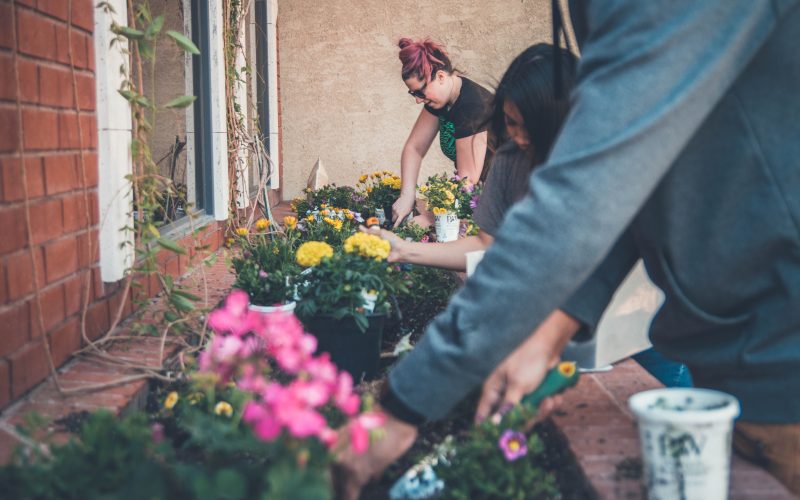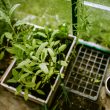Are you tired of constantly running to the grocery store for fresh produce? Do you want to add some greenery and life to your outdoor space? Look no further than an edible garden! Not only is it a great way to save time and money, but it’s also a rewarding hobby that can provide delicious fruits, vegetables, and herbs right at your fingertips. In this blog post, we’ll explore time-saving techniques and the best plants for busy lifestyles so you can thrive on your own home-grown produce. Let’s get started!
Introducing edible gardens
Edible gardens are a great way to bring fresh produce and herbs directly from your backyard to your dinner table. An edible garden is simply a garden that has been created for the purpose of growing vegetables, fruits, and herbs. It’s an environmentally-friendly way of enjoying healthy foods while avoiding the high costs associated with purchasing organic produce.
One of the wonderful things about edible gardens is that they can be tailored to fit any lifestyle or living situation. From small balcony containers to large raised beds, there’s always room for an edible garden in your life.
Growing your own food also means you have complete control over what goes into it – no harmful pesticides or chemicals! Plus, you’ll get all the benefits of being outdoors and working with nature which can be very therapeutic after a long day at work.
There are endless possibilities when it comes to creating an edible garden – vertical gardens for limited space, raised beds for those who have trouble bending down low and even aquaponics systems if you’re feeling adventurous! The sky’s the limit when it comes to creativity in designing your own perfect little patch of paradise.
The benefits of having an edible garden
Having an edible garden in your backyard is more than just a hobby. It comes with numerous benefits that can positively impact both your physical and mental well-being. Here are some of the advantages of having an edible garden:
Firstly, growing your own fruits and vegetables ensures that you have access to fresh produce at all times. This means that you can avoid consuming processed foods which may contain harmful additives.
Additionally, gardening is known to be a stress-relieving activity as it allows you to connect with nature and take a break from the hustle and bustle of daily life. The act of planting, nurturing, and harvesting plants has been linked to improved mood levels.
Moreover, having an edible garden promotes sustainability by reducing the carbon footprint associated with transporting food items over long distances. You will also be contributing towards minimizing food waste as any excess produce can be gifted or donated.
Furthermore, gardening provides an opportunity for family bonding as it encourages teamwork among household members when taking care of the plants.
Having an edible garden is worth considering due to its many benefits such as access to fresh produce throughout the year, reduced stress levels, promoting sustainability while fostering family bonding time through shared activities.
Time-saving tips for busy people
For busy individuals, finding time to maintain an edible garden can be challenging. However, with a few time-saving techniques, it is possible to have a thriving garden without sacrificing too much of your precious time.
Firstly, consider planting in raised beds or containers. Not only do they require less maintenance than traditional garden beds, but they also allow for easy access and mobility when tending to your plants. This means you can take care of your garden even if you only have a few minutes throughout the day.
Another tip for saving time is by selecting low-maintenance plants that are well-suited for your climate. Herbs such as rosemary and thyme require minimal watering and care while still providing plenty of flavor to enhance any dish.
Mulching around your plants is also beneficial in reducing the frequency of watering needed while preventing weeds from taking over. By mulching regularly, you’ll spend less time pulling weeds and more time enjoying the fruits (and vegetables) of your labor!
Consider using automated irrigation systems or setting up rain barrels so that you don’t have to worry about manually watering every day.
By implementing these tips into your gardening routine, maintaining an edible garden becomes manageable even on the busiest days!
The best plants for busy lifestyles
When it comes to creating an edible garden for a busy lifestyle, choosing the right plants is essential. Here are some of the best plants that thrive on neglect and require minimal maintenance:
1. Herbs: These little wonders can be grown in small pots or containers and will add flavor to any dish. Plus, they’re easy to grow and maintain.
2. Tomatoes: This popular fruit (yes, technically it’s a fruit!) grows well in almost any climate and requires very little attention once established.
3. Leafy Greens: Spinach, lettuce, kale, and arugula are all great options for busy people because they grow quickly and can be harvested multiple times throughout the season.
4. Peppers: Whether you prefer sweet or spicy varieties, peppers are another low-maintenance option that will provide plenty of flavor to your meals.
5. Radishes: These root vegetables are one of the easiest vegetables to grow because they mature quickly and don’t require much space or attention.
By selecting these types of plants for your edible garden, you’ll save time while still enjoying fresh produce at home!
How to get started with your own edible garden
Getting started with your own edible garden might seem daunting, but it doesn’t have to be. With a few simple steps, you can start growing your own fresh produce in no time.
Firstly, choose the right location for your garden. Look for a spot that gets plenty of sunlight and has good drainage. If you don’t have a lot of space, consider container gardening or using raised beds.
Next, decide what kind of plants you want to grow. Choose plants that are suited to your climate and soil type and that fit well into your busy lifestyle. Some easy-to-grow options include herbs like basil and mint, leafy greens such as lettuce and spinach, and vegetables like tomatoes and peppers.
Once you’ve chosen your plants, prepare the soil by adding compost or other organic matter to help improve nutrient levels. Water regularly and keep an eye out for pests or diseases.
As you gain more experience with gardening, consider expanding your range of crops or experimenting with different techniques like companion planting or crop rotation.
Remember: starting an edible garden is meant to be fun! Don’t stress too much about getting everything perfect from the outset – take things one step at a time and enjoy watching your garden grow.
Conclusion
Having an edible garden is not only a great way to save time and money but it also provides immense health benefits. With the right plants, tools, and techniques, anyone can start their own thriving vegetable garden no matter how busy their lifestyle may be.
Remember to choose plants that suit your schedule and climate conditions. Opt for low-maintenance varieties like herbs or leafy greens if you’re pressed for time. Utilize time-saving techniques such as installing drip irrigation systems or setting up raised beds.
By incorporating an edible garden into your daily routine, you’ll have access to fresh produce right in your backyard while also reducing food waste. Plus, gardening has been shown to reduce stress levels and improve overall well-being.
So why not give it a try? Start small with just a few pots on your balcony or take on a larger project by transforming part of your yard into a vegetable oasis. Your taste buds (and wallet) will thank you!












